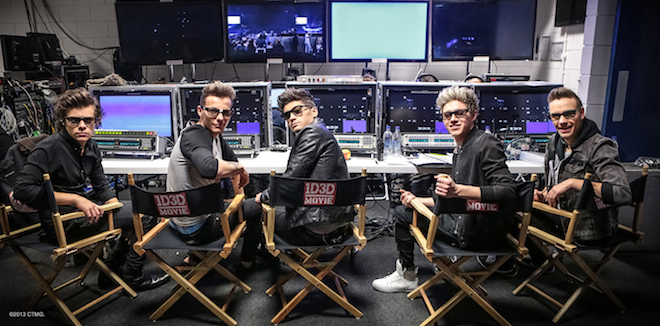One Direction: This is Us — take it, or leave it
Director Morgan Spurlock goes from fast food to terrorism to … boy bands?
Share
For a documentary to gross tens of millions of dollars and reach a worldwide audience, the content must be well-researched, polarizing, political, thoughtful and funny.
Alternatively, it can be about a boy band.
One Direction: This is Us, the boy band’s first authorized big-screen doc, is directed by the biggest personality in documentaries not named Michael Moore. Morgan Spurlock made a name for himself by fattening his organs with McDonald’s in Super Size Me, chasing the world’s most infamous terrorist in Where in the World is Osama Bin Laden? and exposing the world of product placement in The Greatest Movie Ever Sold. The docs won awards at international film festivals and even garnered an Academy Award nomination.
Like many documentary directors, however, what Spurlock didn’t get was screen time at every major Cineplex nor a giant wad of cash. Enter a 3-D film version of 1D.
While Spurlock, with his trademark handlebar mustache, usually takes centre stage in his films, in This Is Us he takes a back seat to five boys named Harry, Niall, Liam, Louis, and Zayn (in order of cuteness). Their story is already well known to fans, the movie’s target audience. They started off as nobodies on the U.K. talent show, The X-Factor, but with a little help from Simon Cowell (of American/British Idol fame) and some Lycra jeans, the five became megastars.
The film is meant to be a “behind the scenes” look at each member of One Direction—although the kind of insight viewers get is mostly limited to how cute Niall’s Irish accent is. (The answer: very!) Apparently the world’s hottest group experiences very little conflict or stress. The boys never forget to mention how much they’d like to thank each and every fan. They’re never seen around friends, parties or alcohol; girlfriends, or talk of them, are absent. Toward the end of the This Is Us, Liam, recovering from a break-up, says: “I want somebody to love me for who I am, not all of this [fame and fortune].” But why sully the film with any details of the relationship?
The One Direction families make brief cameos, but with five stories in 60 minutes of screen time (the other half-hour is dedicated to a concert on-screen), there’s not much insight into family dynamics: mom and dad miss seeing their son; son buys mom and dad new home; all is well. The story arc is done within a few minutes, so as not to deprive fans of screen time for lyrics such as “You don’t know you’re beautiful / That’s what makes you beautiful”— “Mobius pop,” as Stephen Colbert jokingly called it.
In a brief moment of humour, Spurlock breaks away from fans to explain why the non-stop screaming girls who flock to One Direction are not, in fact, crazy. A doctor in a lab coat explains, using a plastic brain, how dopamine is released upon seeing One Direction, causing pleasure and the high-pitch screams.
The film presents nothing new about 1D or its fans, something that is unlikely to deter its preteen audience. But all the while the most interesting person on set remains hidden behind the camera.
No matter what critics say, This Is Us will surely be Spurlock’s biggest commercial success. But at what cost to his reputation? Spurlock’s talent seems far too great to be seen falling in this direction.
